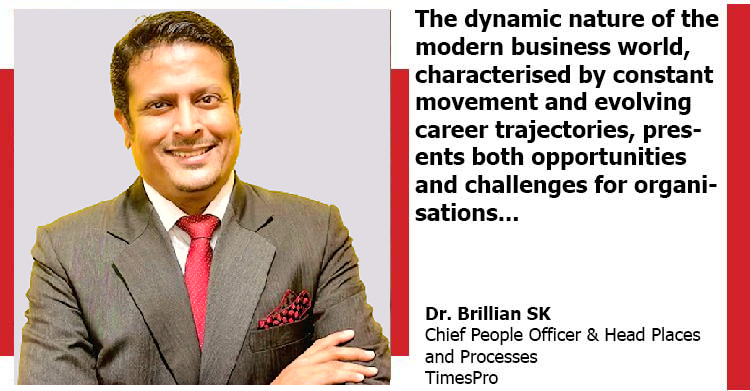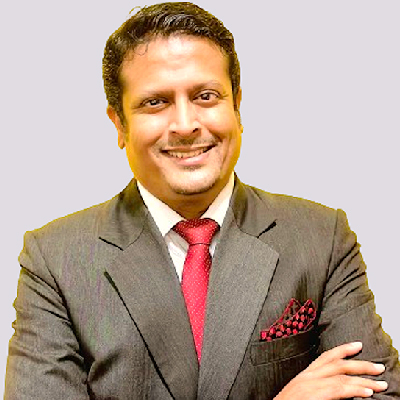Unravelling the Crucial Role of a Strategic HR Leader in Organisations | Dr. Brillian SK | Chief People Officer & Head Places and Processes | TimesPro

The dynamic nature of the modern business world, characterised by constant movement and evolving career trajectories, presents both opportunities and challenges for organisations. In the past, individuals expected a linear career path within the same organisation until retirement. During the ’80s and ’90s, people moved from one place to another until about 40, after which they typically settled into a single career and company. However, this pattern no longer holds true today. Most young professionals now frequently change jobs to acquire new skills and experiences. They may return to the workplace with renewed skills, only to move on in a short while. They also love to change roles within the company. It is a realm where lateral, horizontal, and vertical movement define a contemporary professional journey.
This is a challenge for organisations and Business Leaders. They must be agile and adaptive; but they also need experience and home-grown expertise; they cannot keep losing the talent they have invested in. Moreover, the nature of work itself is changing, even within sectors. All businesses today are technology dependent. While this is true of large business houses, even small family-managed organisations use some form of technology or the other. With technology evolving very rapidly, they must manage obsolescence and keep embracing the latest improvements.
To navigate these challenges, organisations enlist the expertise of a Strategic HR Leader or the Chief Human Resource Officer (CHRO). The CHRO plays a pivotal role in driving company policies to ensure that the changes in the ecosystem keep it resilient against external and internal shocks without diluting the primary business mission. A resilient organisation will be able to keep up its brand equity and customer loyalty. It will be seen to be moving with time, yet uncompromising on its inherent values and culture.
The CHRO is responsible for strategy and building policies in alignment with the organisational goals. The policy itself will consider the vision and mission of the organisation. In the current environment, they work closely with the CEO and drive culture change, policies, and practices. Superposed on these will be modern-day values such as diversity, inclusivity, and equality of opportunity. The HR policy prioritises employee well-being both within and outside the organisation. The CHRO is responsible for driving Talent Management and bridging the skill gap working hand in hand with Business Leaders. Today, this role is no longer an HR responsibility alone.
With the rise of gig economy, companies see a high level of attrition, especially at the entry level. Organisations have to prioritise continuous reskilling and upskilling to cultivate a content and productive workforce. The CHRO must address Business needs with appropriate training of staff based on their requirements and aptitude. Talent is recognised through robust performance management and well-defined performance indicators. Employees are given options to move horizontally across verticals. The CHRO works with the Business leaders to create a roadmap for the company that optimises the contribution of each member. This strategy helps sustain creativity and helps in retaining valuable talent.
To be successful, an organisation needs to be resilient to future shocks. It should be able to adapt to changes in its people, processes, and technology. The CHRO must have an eye on technology gaps and recommend solutions to ensure that productivity increases while staff remain agile and enthusiastic. The solutions make provision for a future vastly different from the present, marked by rapid change. Despite tech advancements, people are still the most valuable assets of an organisation. Each member’s potential is recognised, and efforts are made to continuously engage and motivate staff to “do more”. This creates a workforce that is always alive, engaged and happy; and this can in turn enhance the company’s brand value.
When the morale of staff is high, they automatically become more productive. This makes them efficient and ready to take on demands of growth. It improves profitability of the organisation in the long run. Given the short supply of talent and poor retention rates in a fast-moving talent market, succession planning becomes important since a leadership gap can impact the Business negatively. The HR policy has a succession planning strategy through appropriate leadership development. Those who have leadership potential must be groomed into their roles through mentorship by their seniors. Stakeholders get the sense that the organisation is adaptable and flexible, yet firm on its values. They develop confidence in its resilience.
No job can be successful unless key stakeholders play a crucial role to ensure success. As organisations continues to see challenges on account of VUCA, BANI or any new acronym that crops up, the Strategic HR Leaders and CHRO’s must gear up and stay ahead of the curve by adding value to the Business. From being an execution partner to strategic advisor to the CEO, the role has emerged to be among the key roles that holds potential to build a strong differentiation for the business.
While technology, talent issues, would continue to remain a challenge, building a strong resilient organisation that is geared for the change is one goal that would continue to keep the CHRO’s think and act differenttly.


